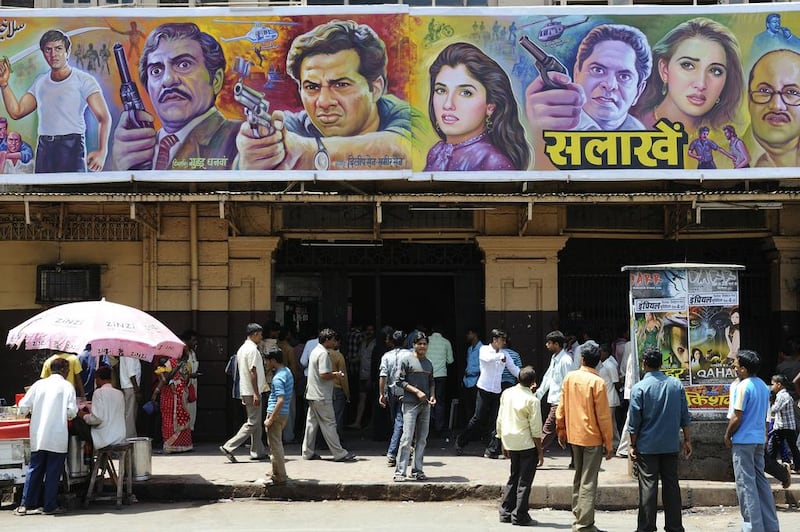A friend from the United States, who is of Indian origin, recently complained to me about the so-called new Bollywood films. “I don’t like it,” she said. “I feel like Hindi movies are losing their innocence. I like songs. They used to be three hours long. Sex scenes feel weird.”
Indian cinema is the second-oldest film industry in the world after Hollywood. And Bollywood is the best-known and now most prolific, according to the number of films certified in 2016, of India’s more-than-20 film industries. And most of these films largely follow the same formula: popular male and female leads; a blend of genres usually referred to as “masala”; and song-and-dance sequences.
The birth of Hindi cinema, aka Bollywood, can be attributed to the release of Indian cinema's first "talkie" Alam Ara in 1931, a musical in Hindi and Urdu that featured seven songs. Its success set the template for Hindi cinema, where song and dance is used as an interruption, as a means of entertainment by itself. This usage mirrors how song and dance are integral to Indian culture, with each community, each festival or ritual having their own.
A number of film critics may look down on the genre, but Bollywood has grown in stature internationally, and stars such as Deepika Padukone have made inroads into Hollywood. It caters to the Indian diaspora as well as a growing number of cinephiles across the world who, ironically, embrace its excesses wholeheartedly. An excerpt from David Kamp and Lawrence Levi's very funny The Film Snob's Dictionary has this observation to make: "The snob prides himself on his populist, un-arty taste, favouring, for example, the soapy, over-emotive schlock of India's Bombay-based 'Bollywood' film industry over the artful, nuanced films of the Calcutta-born [Satyajit] Ray, and the Spaghetti Westerns of the Sergio Leone and Corbucci over anything Fellini ever made. It's a reverse snobbery more powerful than the snobbery it's rebelling against."
Read more: 6 reasons why Bollywood is in crisis
The "soapy, over-emotive schlock" side of Bollywood, however, is currently in a state of crisis. It is facing a number of headwinds such as changing tastes; an outdated star system; a lack of cinema screens across the country (at one screen per 96,300 people, it is the most under-screened major territory in the world, according to Forbes); piracy; and ticket prices that are low by international standards but too expensive for many Indians. Piracy in particular, often in the form of low-quality DVDs and low-resolution downloads, costs the Indian film industry roughly US$2 billion (Dh7.345bn) a year.

Sonam Kapoor in Neerja (2016). Courtesy Fox Star India
There are other financial concerns. Last year, 219 Bollywood titles were released but big studios such as Disney India and Balaji Motion Pictures Ltd suffered losses and decided to take a step back from the movie production business. True figures for revenues generated by Bollywood are difficult to pin down but it’s clear that fewer people are visiting theatres – according to a recent Indo-Asian News Service report, admissions have come down: from 1.46 billion in 2009 to 1.18 billion in 2016.
Compounding the problem is the recent demonetisation move by the Narendra Modi government. Old banknotes of 500 rupees (Dh27) and 1,000 rupees (Dh54) were scrapped in a bid to fight corruption and this has impacted the film industry through temporary limits placed on cash withdrawals. This has negatively affected smaller cinemas, which rely on cash transactions.
So how is Bollywood dealing with these challenges? One of the most obvious changes – again, as a result of outside influences and changing viewer preferences – has been the length of a Hindi film. A list of the longest Indian films includes just one from the past five years: sports biopic M S Dhoni: The Untold Story (2016), at 190 minutes. This trend is in contrast to the established idea of film-watching in India as being a roughly three-hour-long experience.
Bollywood trade analyst Taran Adarsh says the average length of Hindi films has come down by “about 30 to 40 minutes”, especially in the past two years. “Shorter films lead to more shows at multiplexes, so it’s something the industry definitely prefers right now,” he tells me.

Dear Zindagi, featuring Alia Bhatt, left, and Shah Rukh Khan (2016). Courtesy Red Chillies Entertainments
Currently, it feels like studios are going out of their way to woo an audience that’s increasingly finding other means of entertainment.
India was late to satellite TV and broadband internet, so for decades, watching a movie was the most common mode of entertainment. Now, there are multiple ways to spend an evening rather than watching a three-hour film, such as YouTube videos and streaming services like Netflix and Amazon, as well as mall culture.
Another way studios are trying to woo audiences is by cutting songs – now many films now have only five songs as opposed to 10. Songs are now used in montages or situations, without breaking the narrative flow significantly, in contrast to the previous escapist tendencies of Hindi cinema that would find characters suddenly transported to Switzerland or South India’s Nilgiri Hills.
Background scores, too, have assumed more prominence. Early last year, the Shah Rukh Khan starrer Fan, directed by Maneesh Sharma, used the song Jabra Fan to promote the film on TV, radio, and social media but didn't use it or any songs in the film itself. Even the sounds of scores are changing, resembling the work of Hollywood composers such as Hans Zimmer and Thomas Newman. Hindi films are also becoming slicker, grittier and more technically proficient. One could attribute this to influences from Hollywood and world cinema, as well as the South Indian film industry. Particularly, Tamil and Telugu films have been leading the way when it comes to visual effects, digital colour grading and action sequences.
Aniruddha Guha, a film critic and screenwriter, feels the shift in Bollywood has been gradual, but in the late 2000s a palpable change occurred in the tastes of a large section of the audience – largely urban, multiplex-going viewers. "There were those couple of years, between 2007 and 2009, where films like A Wednesday, Bheja Fry, Oye Lucky! Lucky Oye! and Dev D released and were appreciated," he says. "That set the tone for many films to come."
These films marked the beginning of what is now being referred to as the “new Bollywood”: movies with stronger characterisations, offbeat subjects, subtler acting and fewer songs. A new generation of filmmakers, exposed to more world cinema, arrived on the scene and has been trying to balance its own influences with industry expectations. Directors like Dibakar Banerjee, Anurag Kashyap, Abhishek Chaubey and Aanand L Rai started setting their films in Delhi or small-town North India (more natural settings for native Hindi speakers, as opposed to more cosmopolitan Mumbai, where many Bollywood films are set and shot); introduced more interesting characters; and placed more emphasis on realistic dialogue and natural acting. What emerged was a new cinematic language for the traditional, star-driven Bollywood romantic drama – one an increasingly westernised urban youth could relate to.
This isn’t to say that all Hindi films have transformed. If anything, the more commercially successful films often still exhibit the same traits: popular male and female leads; a hit soundtrack; amped-up melodrama; and a general sense of agreement with conservative (read: often patriarchal) values.
What has changed is that there's now more of an attempt at subtlety, realism and writing well-rounded characters – particularly female characters. Films like Queen (2014), a comedy about a young woman who ends up alone on a European honeymoon after her fiancé dumps her; Dum Laga Ke Haisha (2015), a heart-warming story about an overweight schoolteacher (Bhumi Pednekar) who gets married to an entitled man-child in 1990s small-town India; Neerja (2016), the true story of slain flight attendant Neerja Bhanot, whose bravery during the hijacking of Pan Am Flight 73 in September 1986 saved the lives of 377 passengers; and Dear Zindagi (2016), a millennial drama about a young cinematographer that sheds light on mental health, have all been successful in wooing largely urban, multiplex audiences.

Kangana Ranaut in Queen (2014). Courtesy B4U
Not only did these films – considered atypical in dealing with niche subjects and featuring female leads – attract full houses, but many were also more profitable than some of the traditional, star-driven, mainstream entertainers. For example, in December 2015, few trade pundits could have predicted that Dilwale, an entertainer starring Shah Rukh Khan and Kajol, would be out-earned by Bajirao Mastani, a historical film starring Priyanka Chopra, Deepika Padukone and Ranveer Singh that released the same day (December 18).
Dilwale, directed by hit-maker Rohit Shetty, tried to sell viewers star power and exotic locations (Iceland, Bulgaria) but with a flimsy script, a mediocre soundtrack, slipshod acting and jokes that fell flat. Bajirao Mastani featured director Sanjay Leela Bhansali's characteristic attention to detail, with opulent sets, a fantastic score and soundtrack, and strong performances.
The former is typical of traditional Bollywood: cardboard characters, a mish-mash of genres, a throw-everything-at-the-wall-and-see-what-sticks plot and an overreliance on star power. The latter is characteristic of new Bollywood, using songs, grandeur and star power, but in a more controlled, mature manner that better serves the plot and style.
Star-driven films, which typically have higher budgets just on the basis of their renumerations, will still find more screens, but things are changing. In the case of Dilwale, even a wider release did little to help its box-office performance, and it was panned by critics as well as large swaths of the audience. Bajirao Mastani, on the other hand, not only won viewers and critics over, but also went on to sweep film awards ceremonies, including the government-organised 63rd National Film Awards.
Once the staple form of entertainment for the masses, Bollywood now faces stiff competition from all quarters. For many years, the industry could afford to play it safe by making typically “masala”, star-driven entertainers. Now, it has been forced to evolve with the times and try to find a middle ground that will meet the approval of sophisticated viewers as well as conservative ones. It faces financial threats, so the transition to making better content needs to be smooth. More good films need to do well so that producers and studios are compelled to put money into better scripts and support better directors.
How studios will adapt will determine the future of Bollywood.
Suprateek Chatterjee is a former entertainment editor for HuffPost India. His work has appeared in the Times of India, Hindustan Times and Time Out Mumbai.





